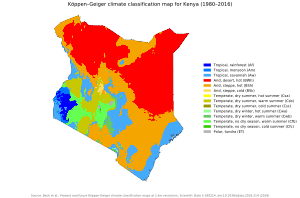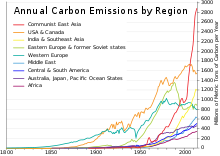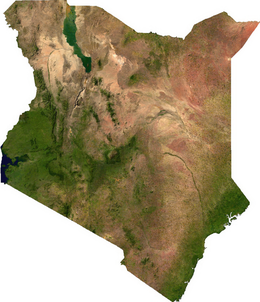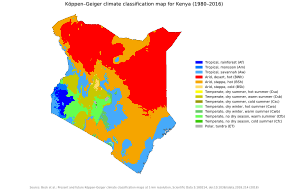|
Geography of Kenya
  The Geography of Kenya is diverse, varying amongst its 47 counties. Kenya has a coastline on the Indian Ocean, which contains swamps of East African mangroves. Inland are broad plains and numerous hills. Kenya borders South Sudan to the northwest, Uganda to the west, Somalia to the east, Tanzania to the south, and Ethiopia to the north. Kenya currently faces border disputes with South Sudan over the Ilemi Triangle and with Somalia over Jubbaland where, if the Somalian Government gives it up, it could be a new part of Kenya, which would bring the total land area of Kenya to approximately 692,939 km2. Central and Western Kenya is characterized by the Kenyan Rift Valley and central Province home to the highest mountain, Mount Kenya and Mount Elgon on the border between Kenya and Uganda. The Kakamega Forest in western Kenya is a relic of an East African rainforest. Much bigger is Mau Forest, the largest forest complex in East Africa. GeographyLocation
Area
Land boundaries
Coastline
Maritime claims
GeologyMuch of the western two-thirds of the country consists of the Pliocene–Pleistocene volcanics deposited on Precambrian basement rocks.[2] The southeast corner of the country is underlain by sediments of the Karoo System of Permian to Late Triassic age and a strip of Jurassic age sediments along the coast in the Mombasa area.[2] The Anza trough is a NW–SE trending Jurassic rift extending from the Indian Ocean coast to the Sudan northwest of Lake Turkana. The Anza Rift resulted from the break–up of Gondwana.[2][3] Climate The climate of Kenya varies by location, from mostly cool every day, to always warm/hot by mid afternoon.[4][5][6] The climate along the coast is tropical. This means rainfall and temperatures are higher than inland throughout the year. At the coastal cities, Mombasa, Lamu and Malindi, the air temperature changes from cool to hot, almost every day. (See chart below).[6] The further inland one is in Kenya, the more arid the climate becomes. An extremely arid climate is nearly devoid of rainfall, and temperature varies widely according to the general time of the day/night. For many areas of Kenya, the daytime temperature rises about 12 °C (corresponding to a rise of about 22 °F), almost every day.[4][5][6]  Elevation is the major factor in temperature levels, with the higher areas, on average, about 11 °C (20 °F) cooler, day or night.[4][5][6] The many cities over a kilometre in elevation have temperature swings from roughly 10–26 °C (50–79 °F). Nairobi, at 1,798 m (5,899 ft), ranges from 9–27 °C (49–80 °F),[4] and Kitale, at 1,825 m (5,988 ft), ranges from 11–28 °C (51–82 °F).[5] At night, heavy clothes or blankets are needed, in the highlands, when the temperature drops to about 10–12 °C (50–54 °F) every night. At lower altitudes, the increased temperature is like day and night, literally: like starting the morning at the highland daytime high, and then adding the heat of the day, again. Hence, the overnight low temperatures near sea level are nearly the same as the high temperatures of the elevated Kenyan highlands. However, locations along the Indian Ocean have more moderate temperatures, as a few degrees cooler in the daytime, such as at Mombasa (see chart below). There are slight seasonal variations in temperature, of 4 °C or 7.2 °F,[4][5][6] cooler in the winter months. Although Kenya is centred at the equator, it shares the seasons of the Southern Hemisphere: with the warmest summer months in December–March and the coolest winter months in June–August, again with differences in temperature varying by location within the country.[4][5][6] On the high mountains, such as Mount Kenya, Mount Elgon and Kilimanjaro, the weather can become bitterly cold for most of the year. Some snowfall occurs on the highest mountains.
Climate changeKöppen climate classification map for Kenya for 1980–2016 2071–2100 map under the most intense climate change scenario. Mid-range scenarios are currently considered more likely.[7][8][9] Climate change is posing an increasing threat to global socioeconomic development and environmental sustainability.[10] Developing countries with low adaptive capacity and high vulnerability to the phenomenon are disproportionately affected. Climate change in Kenya is increasingly impacting the lives of Kenya's citizens and the environment.[10] Climate change has led to more frequent extreme weather events like droughts which last longer than usual, irregular and unpredictable rainfall, flooding and increasing temperatures. The effects of these climatic changes have made already existing challenges with water security, food security and economic growth even more difficult. Harvests and agricultural production which account for about 33%[11] of total Gross Domestic Product (GDP)[12] are also at risk. The increased temperatures, rainfall variability in arid and semi-arid areas, and strong winds associated with tropical cyclones have combined to create favourable conditions for the breeding and migration of pests.[13] An increase in temperature of up to 2.5 °C by 2050 is predicted to increase the frequency of extreme events such as floods and droughts.[10] Hot and dry conditions in Arid and Semi-Arid Lands (ASALs) make droughts or flooding brought on by extreme weather changes even more dangerous. Coastal communities are already experiencing sea level rise and associated challenges such as saltwater intrusion.[10] Lake Victoria, Lake Turkana and other lakes have significantly increased in size between 2010 and 2020[14] flooding lakeside communities.[15] All these factors impact at-risk populations like marginalized communities, women and the youth.[12]  Terrain Kenya's terrain is composed of low plains that rise into central highlands that are, in turn, bisected by the Great Rift Valley. There is also a fertile plateau in the west of the country. Elevation extremesThe lowest point on Kenya is at sea level on the Indian Ocean. The highest point on Kenya is 5,199 meters above sea level at Mount Kenya. RiversThe notable rivers in Kenya are the Athi-Galana-Sabaki River, which at a total length of about 390 kilometers while draining an area of about 70,000 square kilometers, is the second longest river in the country, the Tana River, the longest river in the country at a total length of just over 1000 kilometers, covering a catchment area of over 100,000 square kilometers, and the Nzoia River, which is a 257-kilometre-long (160 mi) river, rising from Mount Elgon, which flows south. Natural resourcesNatural resources that are found in Kenya include: limestone, soda ash, salt, gemstones, fluorite, zinc, diatomite, oil, titanium, gas, gold, gypsum, wildlife and hydropower. Land use9.8% of the land is arable; permanent crops occupy 0.9% of the land, permanent pasture occupies 37.4% of the land; forest occupies 6.1% of the land. Other uses make up the rest of Kenya's land. This is as of 2011. 1,032 km2 of Kenyan land was irrigated in 2003. Total renewable water resources30.7 km3 (2011) Freshwater withdrawal
Gallery
Natural hazardsNatural hazards include recurring drought and flooding during the rainy seasons. There is limited volcanic activity in the country. Barrier Volcano (elev. 1,032 m) last erupted in 1921. Several others have been historically active (see List of volcanoes in Kenya). Environmental issuesCurrent issuesCurrent issues that threaten the environment at the moment include water pollution from urban and industrial wastes; degradation of water quality from the increased use of pesticides and fertilisers; deforestation; water hyacinth infestation in Lake Victoria; soil erosion; desertification; and poaching. International agreements
Extreme pointsThis is a list of the extreme points of Kenya, the points that are further north, south, east or west than any other location.
See alsoReferences
|
|||||||||||||||||||||||||||||||||||||||||||||||||||||||||||||||||||||||||||||||||||||||||||||||||||||||||||||||||||||||||||||||||||||||||||||||||||||||||||||||||||||||||||||||||||||||||||||||||||||||||||||||||||
Portal di Ensiklopedia Dunia







